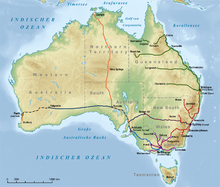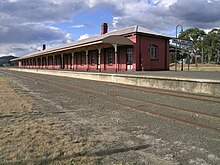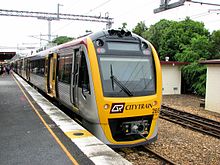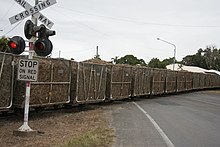Railroad in Queensland
The Railway in Queensland consists mainly of tracks that of Queensland Rail , a private law organized, but the property of the Australian state of Queensland standing railway company operated. In addition, there are private railways that belong to mining, industrial or agricultural companies.
network
Basic structure

The first railway line in Queensland opened on April 25, 1865 from Ipswich to Grandchester and extended to Brisbane in 1876 . As a result, a number of branch lines were created, some of which were considerable in length, which opened up the hinterland from ports on the coast. From 1867 the railway operated from Rockhampton , from 1882 from Townsville westwards. The basic economic consideration was to give the cattle-rearing communities in the hinterland access to seaports. Only later were the lines connected by a line running parallel to the coast. The last of the branch lines was not connected to the network until 1903, which gave it its comb-shaped structure: a main line on the coast from Brisbane to the north, with branch lines branching off to the west. Today the narrow gauge network in Queensland is one of the largest in the world.
Gauge

Before the amalgamation of the colonies to form the Australian state in 1901, they were legally independent of each other and the decision on the gauge in which the respective railroad was to be built was a matter for the individual colony. In Queensland, which was less populated and economically weaker than the southern colonies, the decision was made in favor of the Cape Track . This was cheaper to build and allowed smaller curve radii. With a narrow majority, the Queensland Parliament decided in 1863 for this technical solution. At the time, it was assumed that the maximum speed would be around 30 km / h and that this system would be sufficient for the next 100 years.
The great technical difficulties that arose from crossing the Great Dividing Range by a railway line were quickly overcome. The trains ran to Toowoomba as early as 1867 . The work on the line also benefited from a wave of immigration, which provided the railway construction sites with sufficient workers.
On the southern border of the state, however, the train encountered the standard-gauge route network of New South Wales from 1888 at Wallangarra gauge changing station , where travelers had to change trains and goods had to be reloaded. The now used, shorter and completely standard-gauge line to Brisbane has been in existence since 1930. Its railway infrastructure belonged to the state of Queensland, while the railroad operated in New South Wales . Freight traffic on this route was transferred to the National Rail Cooperation in 1994 , which is now operated by Pacific National . Today passenger offers Country link to.
expansion
An electrification of the routes in Queensland is done only from the late 1970s. The train from Brisbane was electrified in 1979 and 1986, the electric traction Coal shipments began in Central Queensland. The route from Brisbane to Rockhampton was electrified in 1989.
In 2001 the connection from Brisbane to its airport went into operation. This connection, called “Airtrain”, was built in an operator model that stipulates that the private builder and operator of the route must transfer it to the state after 35 years of operation. This is one of the few routes in Queensland on which private rail services for third parties are offered on their own route.
organization
The main lines and some of the branch lines in Queensland were built by the state and operated by a state railway, the Queensland Rail . Queensland Rail founded the freight subsidiary QR National in 2005 and began transporting coal in Hunter Valley . In the same year the CRT Group was integrated and the Australian Railroad Group was taken over in 2006. Queensland Rail was reorganized under private law in 2007 as QR Limited . However, the shares of this GmbH remained completely in state ownership.
As of July 1, 2010, the commercial operation was separated from the company and separated from the rail passenger transport defined as a public service and merged into a company called QR National Limited in order to sell it.
Since 2005, other rail companies have been operating on the Queensland rail network. The first company was the Pacific National .
business
vehicles
The locomotives for the opening of the first line in 1865 came from the Avonside Engine Company , Bristol, from England.
QR Limited had 717 locomotives on June 30, 2008.
Long-distance connections
Long-distance transport is offered by Traveltrain , a division of QR Limited. The tourist segment in terms of traffic is high. In detail it concerns:
-
Tilting trains ("QR Tilt Train"). A train of this type set the Australian speed record for trains in 1999 at 210 km / h. These trains have been around since 1998:
- Electric multiple units on the Brisbane – Rockhampton connection
- Diesel multiple units on the Brisbane – Cairns connection
- The standard gauge service between Sydney and Brisbane is Brisbane Limited , a CountryLink service .
- The Sunlander was a traditionally locomotive hauled train and operated on the Brisbane – Cairns route. The Sunlander has been replaced by the modern, much faster " Spirit of Queensland "since 2014.
- The Spirit of the Outback , Brisbane - Longreach
- The Inlander , on the Townsville - Mount Isa route , has been available since February 12, 1953.
- The Westlander : Brisbane– Charleville
Tourist railways
Pure tourism railways are:
- The Gulflander , an island between Normanton and Croydon, is a railway line in northern Queensland that is only used for tourismandis completely isolated from the rest of the network.
- The Kuranda Scenic Railway between Cairns and Kuranda
- The Savannahlander between Cairns and Forsayth
Sugar cane railways
There are around 20 networks of sugar cane railways in Queensland, usually with a gauge of 610 mm. Each of these belong to a sugar factory and some of them have a high technical standard with continuous train brakes and the routes are also laid in sections on concrete sleepers . These railways cooperate with each other, even if the networks are not connected. In the state of greatest expansion, there were around 3200 km of routes. At least one of them, the Mossmann Mills railway, also offered public passenger and freight transport. A section of this connection has been preserved as a museum railway .
literature
- Jim Powe: Trains and Railways of Australia. 2nd Edition. Sydney 2009, ISBN 9781741109023 .
- Walter G. Steingahs: 4,000 km on a 610 mm track. The sugar cane railways in Queensland, Australia . Feld- und Schmalspurbahn-Verlag Karl Paskarb, 2002, ISBN 3-938278-03-X
Movie
- Beyer-Garratt Locomotives Round the World: Queensland . Great Britain 1948. 16 mm color film, 17 minutes.
Individual evidence
- ^ Brisbane Times: Queensland Asset Sales to Reap 5 Billion
- ↑ S uburban M ultiple U nit
- ↑ See here
- ↑ Robin Bromby (2004). The Railway Age in Australia. Lothian Press, 99. ISBN 0-7344-0715-7 .
- ↑ http://www.mossag.com.au/TransportFacts.html
- ^ After John Huntley: Railways in the Cinema . London 1969, p. 115, available from the British Film Institute .





